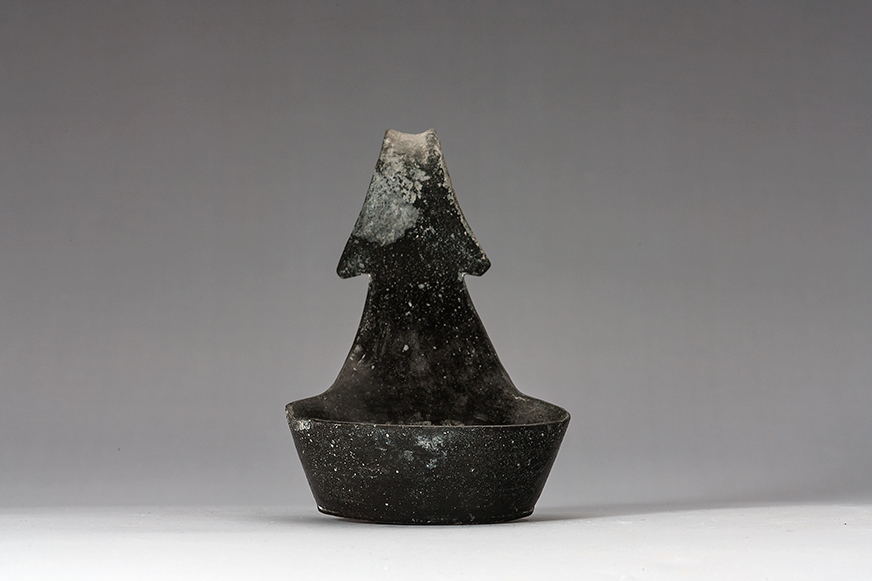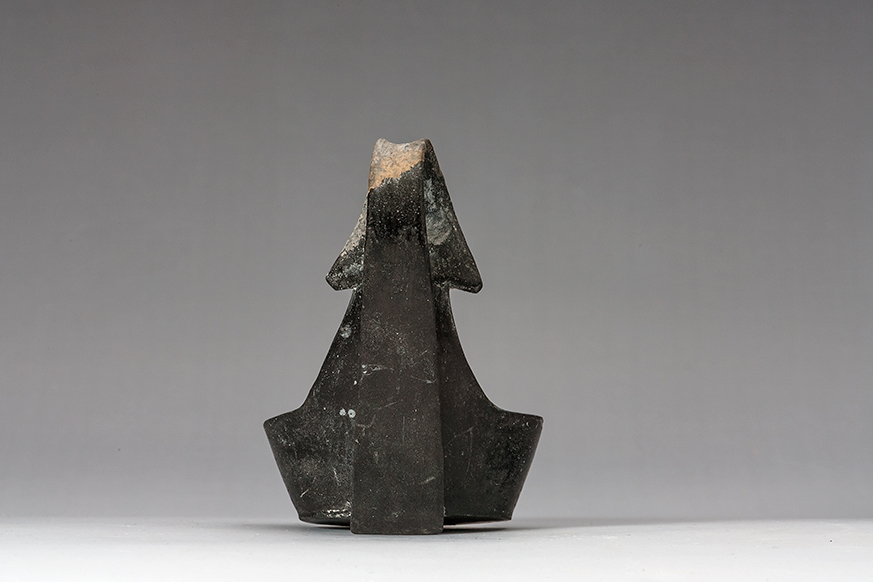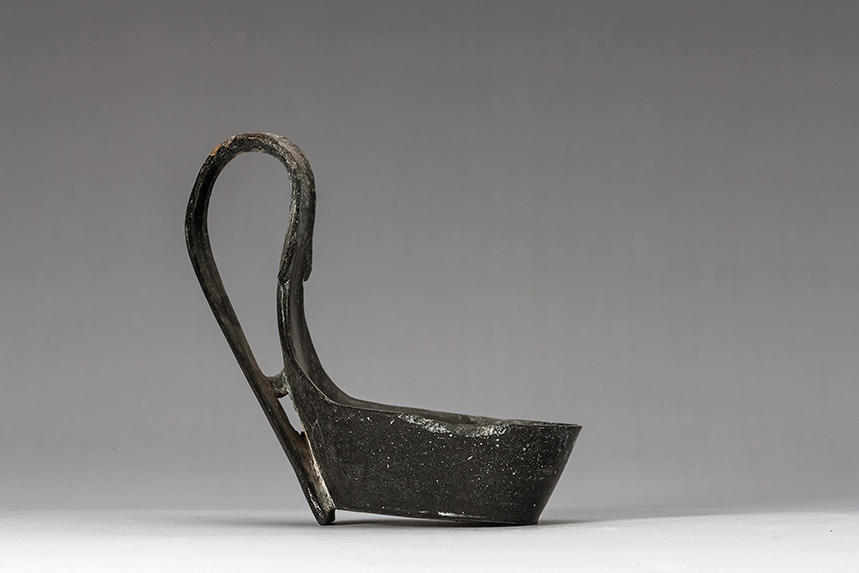Title: Etruscan Bucchero Kyathos - 1968.10
Acquisition number: 1968.10
Author or editor: J.R. Green
Culture or period: Etruscan.
Date: c. Second half 6th century BC.
Material: Clay
Object type: Vessels
Dimensions: 80mm (w) × 111mm (h)
Origin region or location: Italy
Origin city: Etruria.
Display case or on loan: 12
Keywords: Etruscan, Bucchero
Folio Fine Art Ltd (London), Catalogue 51, no. 610 (ill.); J.R. Green with B. Rawson, Catalogue of Antiquities in the Australian National University, A.N.U. (Canberra, 1981) 23.
1968.10
Etruscan Bucchero Kyathos
Purchased. Max. ht 11.1cm; ht (bowl) 2.8cm; diam. (bowl) 8cm.
Intact but for surface damage in some areas. Finely made with a smooth polished surface. High spurred band handle that projects below the level of the bowl at the bottom. The base of the bowl is slightly offset from the wall.
Bucchero is probably the most typical Etruscan pottery of the archaic period. It was developed in the mid-seventh century BC and continued to be produced until the beginning of the fifth. The principal area of production seems to have been in southern Etruria, for instance at Tarquinia and Veii but particularly at Cerveteri. Somewhat heavier varieties were made in the north, especially at Chiusi. The pottery, which is black in the core as well as on the surface, was given its character by firing in a reducing atmosphere, thus producing the black ferrous oxide in the clay.
The kyathos, or ladle, was one of the more characteristic shapes, and indeed one that was copied in Athens in the workshop of Nikosthenes (amongst others) for export to Etruria. The bucchero version comes in three main types, the other two of which have a distinct foot. This type has the bottom of the handle coming below the level of the cup’s base, a feature which would not only lessen the amount of dirt that could cling to the ladle’s base, but, perhaps more importantly, prevent the ladle from tipping over with the weight of the handle.
There has been considerable work on bucchero in recent years. There is a good survey and discussion of early bucchero by N.H. Ramage, “Studies in Early Etruscan Bucchero”, Papers of the British School at Rome 38, 1970, 1-61 and a good collection of papers in M. Bonghi Jovino (ed.), Produzione artigianale ed esportazione nel mondo antico. Il bucchero etrusco. Atti del Colloquio Internazionale, Milano, 10-11 maggio 1990 (Milan 1993). Important now is J. Gran-Aymerich, Les vases de bucchero et le monde étrusque entre Orient et Occident, i-ii (Bibliotheca Archaeologica, 55 Rome 2017), with further references as well; as the same author’s “Le bucchero et la société étrusque: origines, production, diffusion, usages et réception”, Phersu 1, 2018, 75-90. Note also the collections published in Corpus Vasorum Antiquorum British Museum (7) and Corpus Vasorum Antiquorum Louvre (20). Also T.B. Rasmussen, The Bucchero Pottery from Southern Etruria (Cambridge 1979) and the useful overview by J.W. Hayes, Etruscan and Italic Pottery in the Royal Ontario Museum (Toronto 1985). Hayes has some other varieties of kyathos on pp. 78-79. For other versions of the shape, see also the important study by P. Perkins, Etruscan Bucchero in the British Museum (London 2007) nos 204-216.
There has been a great deal of discussion of the relationship between the bucchero versions and their Attic counterparts. A good starting point is T. Rasmussen, “Etruscan Shapes in Attic Pottery”, Antike Kunst 28, 1985, 33-39; then W. Regter, “Some Remarks on the Relation between Early Etruscan Bucchero and Greek Ceramics”, in: B. Schmaltz and M. Söldner (eds), Griechische Keramik im kulturellen Kontext. Akten des Internationalen Vasen-Symposions in Kiel vom 24.-28.9.2001 (Münster 2003) 223-224; N. Malagardis, “Un Étrusque dans les ateliers du Céramique vers 520 avant J.-C. Autoportrait d’un étranger”, in: F. Giudice and R. Panvini (eds), Il greco, il barbaro e la ceramica attica. Immaginario del diverso, processi di scambio e autorappresentazione degli indigeni IV (Rome 2007) 27-43; M. Giuman and C. Pilo, “Il kyathos attico. Un vaso etrusco nel Ceramico di Atene”, in: S. Angiolillo, M. Giuman, C. Pilo (eds), Meixis. Dinamiche di stratificazione culturale nella periferia greca e romana. Atti del convegno internazionale di studi (Cagliari, Cittadella dei Musei, 5-7 maggio 2011) (Archaeologica 169, Rome 2012) 19-36; D. Tonglet, “Kyathoi étrusques et attiques. Double réception d’une forme de bucchero dans les ateliers de vases figurés à Athènes et Vulci”, Annales d'Histoire de l'Art et d'Archéologie 35, 2013, 27-49. An important recent contribution is N. Malagardis, “Athéniens et Étrusques à l’époque archaïque, le temps du récit – Nikosthénès, Théozotos et les autres”, in: V. Bellelli and Á.M. Nagy (eds), Superis deorum gratus et imis. Papers in Memory of János György Szilágyi (Rome 2018) 101-122.
On the use of kyathoi and other vessels in the symposion, see M. Tiverios, “‘Ηθμοειδής κύαθος’”, in: Πότνια οἰνου. ΔιεθνέςἐπιστημονικὁσυμπόσιοΣταυρούλαςΚουράκου-Δραγώνα (Volos 2009) 95-116.
Probably second half of the sixth century BC.
Bibl.: Folio Fine Art Ltd (London), Catalogue 51, no. 610 (ill.); J.R. Green with B. Rawson, Catalogue of Antiquities in the Australian National University, A.N.U. (Canberra, 1981) 23.



